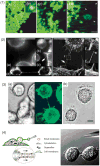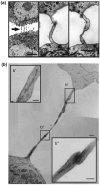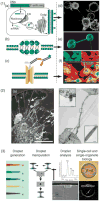Intercellular nanotubes: insights from imaging studies and beyond
- PMID: 20166114
- PMCID: PMC5602582
- DOI: 10.1002/wnan.80
Intercellular nanotubes: insights from imaging studies and beyond
Abstract
Cell-cell communication is critical to the development, maintenance, and function of multicellular organisms. Classical mechanisms for intercellular communication include secretion of molecules into the extracellular space and transport of small molecules through gap junctions. Recent reports suggest that cells also can communicate over long distances via a network of transient intercellular nanotubes. Such nanotubes have been shown to mediate intercellular transfer of organelles as well as membrane components and cytoplasmic molecules. Moreover, intercellular nanotubes have been observed in vivo and have been shown to enhance the transmission of pathogens such as human immunodeficiency virus (HIV)-1 and prions in vitro. These studies indicate that intercellular nanotubes may play a role both in normal physiology and in disease.
Figures









Similar articles
-
Intercellular transfer mediated by tunneling nanotubes.Curr Opin Cell Biol. 2008 Aug;20(4):470-5. doi: 10.1016/j.ceb.2008.03.005. Epub 2008 May 2. Curr Opin Cell Biol. 2008. PMID: 18456488 Review.
-
Wiring through tunneling nanotubes--from electrical signals to organelle transfer.J Cell Sci. 2012 Mar 1;125(Pt 5):1089-98. doi: 10.1242/jcs.083279. Epub 2012 Mar 7. J Cell Sci. 2012. PMID: 22399801 Review.
-
Lipid droplets as a novel cargo of tunnelling nanotubes in endothelial cells.Sci Rep. 2015 Jun 22;5:11453. doi: 10.1038/srep11453. Sci Rep. 2015. PMID: 26095213 Free PMC article.
-
A transwell assay that excludes exosomes for assessment of tunneling nanotube-mediated intercellular communication.Cell Commun Signal. 2017 Nov 13;15(1):46. doi: 10.1186/s12964-017-0201-2. Cell Commun Signal. 2017. PMID: 29132390 Free PMC article.
-
Role of connexin 43 in different forms of intercellular communication - gap junctions, extracellular vesicles and tunnelling nanotubes.J Cell Sci. 2017 Nov 1;130(21):3619-3630. doi: 10.1242/jcs.200667. Epub 2017 Oct 12. J Cell Sci. 2017. PMID: 29025971 Review.
Cited by
-
Peering into tunneling nanotubes-The path forward.EMBO J. 2021 Apr 15;40(8):e105789. doi: 10.15252/embj.2020105789. Epub 2021 Mar 1. EMBO J. 2021. PMID: 33646572 Free PMC article. Review.
-
The chaperone ERp29 is required for tunneling nanotube formation by stabilizing MSec.J Biol Chem. 2019 May 3;294(18):7177-7193. doi: 10.1074/jbc.RA118.005659. Epub 2019 Mar 15. J Biol Chem. 2019. PMID: 30877198 Free PMC article.
-
Helical organization of microtubules occurs in a minority of tunneling membrane nanotubes in normal and cancer urothelial cells.Sci Rep. 2018 Nov 20;8(1):17133. doi: 10.1038/s41598-018-35370-y. Sci Rep. 2018. PMID: 30459350 Free PMC article.
-
Tunneling Nanotubes as a Novel Route of Cell-to-Cell Spread of Herpesviruses.J Virol. 2018 Apr 27;92(10):e00090-18. doi: 10.1128/JVI.00090-18. Print 2018 May 15. J Virol. 2018. PMID: 29491165 Free PMC article.
-
Direct Transfer of Mesoporous Silica Nanoparticles between Macrophages and Cancer Cells.Cancers (Basel). 2020 Oct 9;12(10):2892. doi: 10.3390/cancers12102892. Cancers (Basel). 2020. PMID: 33050177 Free PMC article.
References
-
- Wolpert L, Gustafson T. Studies on the cellular basis of morphogenesis of the sea urchin embryo. The formation of the blastula. Exp Cell Res. 1961;25:374–382. - PubMed
-
- Ramirez-Weber F, Kornberg T. Cytonemes: cellular processes that project to the principal signaling center in Drosophila imaginal discs. Cell. 1999;97:599–607. - PubMed
-
- Miller J, Fraser S, McClay D. Dynamics of thin filopodia during sea urchin gastrulation. Development. 1995;121:2501–2511. - PubMed
-
- Rustom A, Saffrich R, Markovic I, Walther P, GerdesH Nanotubular highways for intercellular organelletransport. Science. 2004;303:1007–1010. - PubMed
-
- Önfelt B, Nedvetzki S, Yanagi K, Davis DM. Cutting edge: membrane nanotubes connect immune cells. J Immunol. 2004;173:1511–1513. - PubMed
Intercellular nanotubes
-
- Sowinski S, Jolly C, Berninghausen O, Purbhoo MA, Chauveau A, Köhler K, Oddos S, Eissmann P, Brodsky FM, Hopkins C, Önfelt B, Sattentau Q, Davis DM. Membrane nanotubes physically connect T cells over long distances presenting a novel route for HIV-1 transmission. Nature Cell Biology. 2008;10:211–219. doi: 10.1038/ncb1682. - DOI - PubMed
Nanotube-Vesicle Networks
HIV and ICNs
-
- Jones S. Cell Biology: Tube travel for HIV? Nature Reviews Microbiology. 2008;6(3):175. doi: 10.1038/nrmicro1866. - DOI
Publication types
MeSH terms
Grants and funding
LinkOut - more resources
Full Text Sources
Miscellaneous

